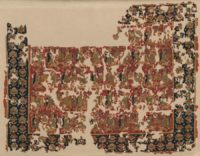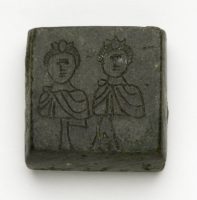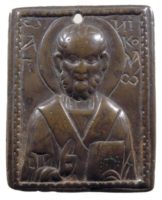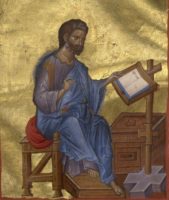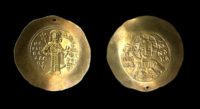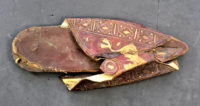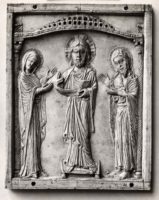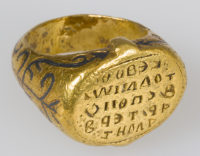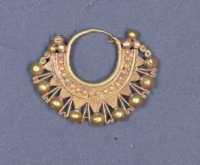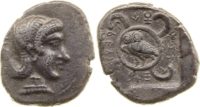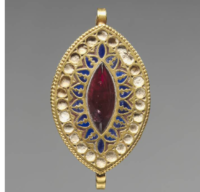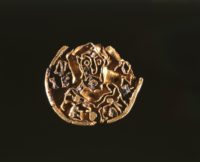Relief icon; Period: Late Byzantine, circa: 14-15th c. carved white steatite in the shape of half an oval; St George and the dragon with name inscribed. Length: 2 centimetres Width: 1.6 centimetres. British Museum is closed 24, 25 and 26 December and 1 January, but is open every other day of the year. Fast facts about the British Museum: Founded: 1753, Collection size: 8 million objects, Oldest object in the collection: Stone chopping tool (nearly 2 million years old).
Fragment of a Large Hanging, Period: Early Byzantine; circa: 6th century, Made in: Egypt. Materials: tapestry weave (with plain tabby borders): wool and linen. The Cleveland Art Museum Hours: Tuesdays, Thursdays, Saturdays, Sundays 10:00 a.m.–5:00 p.m. Wednesdays, Fridays 10:00 a.m.–9:00 p.m. Closed Mondays.
[xyz-ihs snippet="Cleveland-Museum-Art-Booking-Deals-Finder"]Copper alloy weight, Period: Early Byzantine, circa: 4thC-5thC. Quare with convex profile & chamfered lower edges; engraved on face with 2 imperial busts. British Museum is closed 24, 25 and 26 December and 1 January, but is open every other day of the year. Fast facts about the British Museum: Founded: 1753, Collection size: 8 million objects, Oldest object in the collection: Stone chopping tool (nearly 2 million years old).
Small icon of St Nicholas. Period: Late Byzantine; circa: First half of 13th century. Materials: bronze. The Benaki Museum of Greek Culture is housed in one of the most beautiful neoclassical-style buildings in Athens, near the National Garden and the Hellenic Parliament. It was converted into a museum in order to shelter the collections of Antonis Benakis and was donated to the Greek nation by himself and his three sisters, Alexandra, Penelope and Argine. Following its most recent refurbishment (1989–2000), the building houses a unique exhibition on Greek culture arranged diachronically from prehistory to the 20th century.
Buckle with Garnets. Period: Early Byzantine; circa:400–500 A.D. Material: gold. Made in: Constantinople. The Metropolitan Museum of Art (New York) is one of the world’s largest and finest art museums. Its collection includes more than two million works of art spanning five thousand years of world culture, from prehistory to the present and from every part of the globe. Public Hours: 10:30 a.m.–5:30 p.m. Open seven days a week.
Saint Mark. Period: Late Byzantine circa: late 13th century. Place: Constantinople (Place created) Dimensions: Leaf: 21 × 14.9 cm (8 1/4 × 5 7/8 in.). Museum Description: “Saint Mark pauses, quill in hand, as he writes his account of the life of Christ. This portrait of the saint as author introduces his Gospel in a Greek manuscript of the late 1200s. An inscription in red on the gold leaf background identifies the saint by name. ” The J. Paul Getty Museum at the Getty Center in Los Angeles houses European paintings, drawings, sculpture, illuminated manuscripts, decorative arts, and photography from its beginnings to the present, gathered internationally.
Silver Coin, Period: 4 th century B.C. 330BC (circa); Museum Description: “Silver coin.(obverse) Head of nymph Sinope waring earring. (reverse) Eagle above dolphin.” Minted in: Sinope (Modern Turkey, Black Sea Region Sinop Province) British Museum is closed 24, 25 and 26 December and 1 January, but is open every other day of the year. Fast facts about the British Museum: Founded: 1753, Collection size: 8 million objects, Oldest object in the collection: Stone chopping tool (nearly 2 million years old).
Quantity of pearl, tourmaline, glass, coral and bronze beads, once attached no doubt to cloth. Period: Early Byzantine circa: 6-7th century. Made in/Findspot: Constantinople. In the Istanbul Archaeological Museum collections, there are rich and very important works of art belonging to various civilizations from the regions from Africa to Balkans , from Anatolia and Mesopotamia to Arab Peninsula and Afghanistan that were in the borders of the Ottoman Empire.
Gold Signet Ring, Period: Late Byzantine circa: 14thc. Made in: Constantinople. Diameter: 28 millimetres Weight: 375 grains. British Museum is closed 24, 25 and 26 December and 1 January, but is open every other day of the year. Fast facts about the British Museum: Founded: 1753, Collection size: 8 million objects, Oldest object in the collection: Stone chopping tool (nearly 2 million years old).
Gold coin; Ruler: Manuel I Comnenus, Byzantine emperor; Period: Middle Byzantine; circa: 1143-1180; Minted in Constantinople. British Museum is closed 24, 25 and 26 December and 1 January, but is open every other day of the year. Fast facts about the British Museum: Founded: 1753, Collection size: 8 million objects, Oldest object in the collection: Stone chopping tool (nearly 2 million years old).
Necklace; Cross pendant; Period: Early Byzantine; 5thc.-6thc.; Materials: glass, amber, amethyst and carnelian beads. Found: Qaw el-Kebir, Egypt, Upper Egypt. British Museum is closed 24, 25 and 26 December and 1 January, but is open every other day of the year.
Slipper; leather; with pointed toe and thick sole with gilt borders on the upper part and the figure of an animal. Culture: Coptic. Period: Early Byzantine; circa: 4thC-6thC; Made in: Egypt. Length: 262 millimetres. British Museum is closed 24, 25 and 26 December and 1 January, but is open every other day of the year. Fast facts about the British Museum: Founded: 1753, Collection size: 8 million objects, Oldest object in the collection: Stone chopping tool (nearly 2 million years old).
Ivory Panel, carved with standing figures, Christ with the Virgin Mary and St John, below a pierced canopy; four holes for attachment in the raised border. Period: Middle Byzantine circa: 10thc. Materials: Ivory. British Museum is closed 24, 25 and 26 December and 1 January, but is open every other day of the year. Fast facts about the British Museum: Founded: 1753, Collection size: 8 million objects, Oldest object in the collection: Stone chopping tool (nearly 2 million years old).
Gold Earring, Period: Middle Byzantine. circa: 12thc. Length: 1.24 inches. British Museum is closed 24, 25 and 26 December and 1 January, but is open every other day of the year. Fast facts about the British Museum: Founded: 1753, Collection size: 8 million objects, Oldest object in the collection: Stone chopping tool (nearly 2 million years old).
Signet Ring of John, Imperial Spatharios, Period: Middle Byzantine, circa: 10th century, Materials: Gold, niello. On view at The Met Fifth Avenue in Gallery 300 . Museum Description: “The title spatharios, Sword-Bearer, was originally an honor reserved for the imperial bodyguard. By the middle Byzantine period, it had become an honorific title only, indicating Ioannis’s respectable status.” The Metropolitan Museum of Art (New York) is one of the world’s largest and finest art museums. Its collection includes more than two million works of art spanning five thousand years of world culture, from prehistory to the present and from every part of the globe. Public Hours: 10:30 a.m.–5:30 p.m. Open seven days a week.
Earring; Period: Middle Byzantine; 11thc.-12thc. Material: gold. British Museum is closed 24, 25 and 26 December and 1 January, but is open every other day of the year.
Silver Coin, Period: 5th c. 410 B.C. (circa) Minted in Lycia, Anatolia, Turkey. Ruler: Khariga, Materials: silver. Museum Description: Head of Aphrodite left, rows of formal curls on fore-head, hair fastened by band passing three times round it, and caught up behind; truncation on neck dotted; symbol, resembling T on neck.
(reverse) Tetraskeles right, members of which divide the legend; in inner ring, owl standing left, head to front; symbol at beginning of inscription: the whole. British Museum is closed 24, 25 and 26 December and 1 January, but is open every other day of the year. Fast facts about the British Museum: Founded: 1753, Collection size: 8 million objects, Oldest object in the collection: Stone chopping tool (nearly 2 million years old).
Almond-Shaped Pendant, Period: Early Byzantine, circa: 400-600. Materials: gold, lapis lazuli, garnet, and glass. The Cleveland Art Museum Hours: Tuesdays, Thursdays, Saturdays, Sundays 10:00 a.m.–5:00 p.m. Wednesdays, Fridays 10:00 a.m.–9:00 p.m. Closed Mondays.
Gold Coin. Ruler: Leo III. Period: Middle Byzantine, circa: 717-741. Minted in: Ravenna. Weight: 1.484 grammes. British Museum is closed 24, 25 and 26 December and 1 January, but is open every other day of the year. Fast facts about the British Museum: Founded: 1753, Collection size: 8 million objects, Oldest object in the collection: Stone chopping tool (nearly 2 million years old).
Vollschmelz medallion (9th Century – Middle Byzantine Period). Gold cloisonné; bust of St. Nicholas, his right hand raised in benediction, a book in his left; inscription. British Museum is closed 24, 25 and 26 December and 1 January, but is open every other day of the year. Fast facts about the British Museum: Founded: 1753, Collection size: 8 million objects, Oldest object in the collection: Stone chopping tool (nearly 2 million years old).



